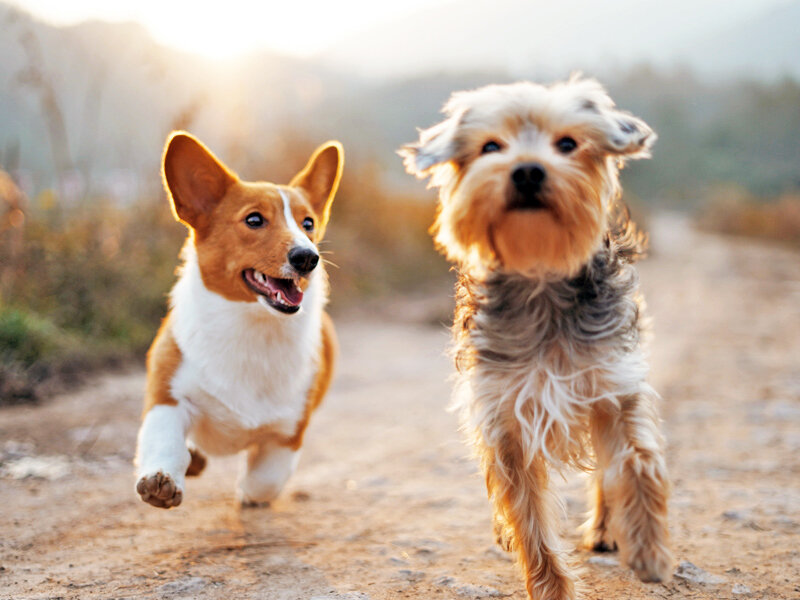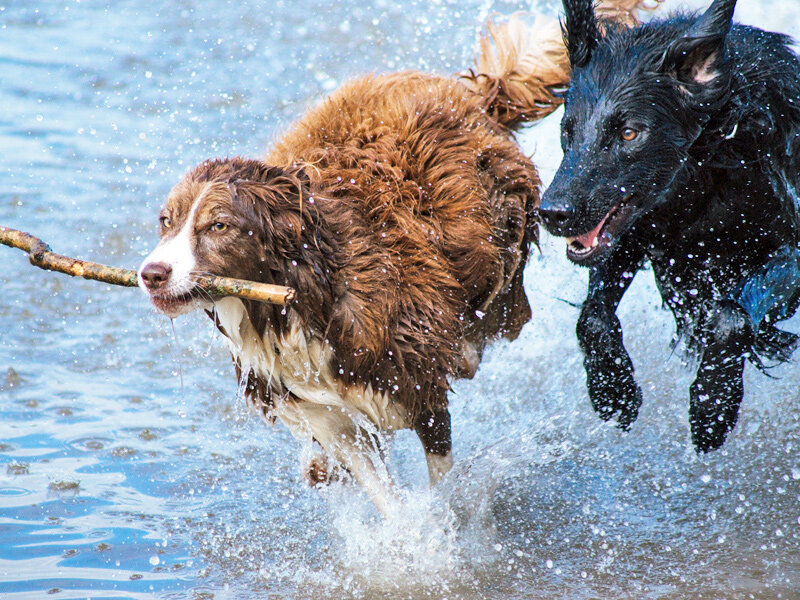to dog-park-it or not
Here’s a quick guide to help you and your pooch have a fun, safe time at the dog park.
+make the right choice
DOG PARKS ARE APPROPRIATE IF
your dog is at least 6 months old—and preferably 1-3 years (dog-park sweet spot for most)
your dog is already well socialized to dogs and people and has bite inhibition (soft mouth with people and dogs)
your dog is already bonded to you and responsive to recalls
your dog is comfortable and well behaved around other people and dogs
your dog doesn’t guard any resources—people, toys or food
you understand dog body language (read Calming Signals by Turid Rugaas)
you’re prepared to leave if the other dogs or their people behave inappropriately
DO NOT GO TO THE DOG PARK IF YOUR DOG IS
younger than 6 months
shy around other dogs or people
reactive or aggressive
not feeling well
small, and there’s no designated area for small dogs
in heat (receptive female at any point in her 2–4-week heat cycle)
an intact male*
*You’ve worked hard to raise a friendly, well-socialized furry boy. Don’t risk it at a dog park. By around 10 months of age, intact males commonly elicit unfriendly responses from neutered males. Your puppy’s hormonal signature becomes a threat; the neutered dog goes for your puppy, and his happy-go-lucky attitude toward other dogs might change forever. Not worth it! Our recommendation: If you plan to take your male dog to dog parks on a regular basis, neuter him before he begins to elicit a response from the neutered adult males. If you don't want to neuter him, choose other activities.
+top 4 things to know before going
1| many dogs aren’t that into it
Before deciding to hit the dog park, consider whether it’s something your dog enjoys. For many it’s not; they really aren’t that into it. Opt for alternative exercise outlets such as fetching, hiking, running and swimming with you and perhaps another known dog-friend. In the end, you and your dog will be safer and happier for it!
2| most people don’t know what good dog play looks like
A recent study found that the top 5 behaviors observed in dog parks were dangerous and maladaptive bully behaviors. So if you or your dog becomes uncomfortable and another dog park-goer tells you “that’s just how they play,” “they need to learn by being told off by the other dogs” or “let them work it out,” be very skeptical. Many dogs who’ve been left to “work it out” have been mentally and/or physically injured. Some have even been killed. Remember, you’re the only one who can advocate for your dog and keep her safe. Sometimes that may mean leaving and coming back another day.
3| all dog parks aren’t created equal
The best dog parks share these attributes:
large in size with multiple, double-gated entrances
terrain variety—hills, trees/plants, multiple ground substrates, water + play structures
separate area for small/fragile/timid dogs
walking paths to encourage movement
allowance of 1–2 dogs only per person
recommendation that puppies under 6 months not visit
4| preparation and knowhow are key
Take a sealed backpack of supplies with you—leash, treats, toy, water bowl, water, poop bags and emergency citronella spray.
Learn canine body language ahead of time so you’ll know when your dog becomes uncomfortable or over-excited and may need your help—read Calming Signals by Turid Rugaas
The best time to visit is during off-hours: weekdays from 9–11a and 2–4p, before 6a and after 8p.
Stay attentive to your dog at all times—no cell phones or headphones—and prevent problems before they arise.
—If dogs are becoming very tense or intense (exhibiting extreme avoidance, stiffness or over-the-top play), leave for a relaxation break.
—Be ready if things go wrong. Have emergency citronella spray to use in case of a fight. Leave—you can’t control others, but you can control what you do!
+a few more tips
Know before you go. Scan the park before entering to make sure there are no inappropriate dogs present. If there are, leave and return another time.
Immediately intercept inappropriate and dangerous behaviors like ganging up and multiple-dog chase, which can lead to fear and/or predatory aggression.
Encourage movement. Walk around the edges of the park and avoid congregating.
Check in and connect with your dog often.
Don’t stay unless your dog looks VERY happy to be there.
If your dog is constantly skirting the perimeter while sniffing the ground, seeking you out for comfort when dogs approach, avoiding other dogs or trying to tell them off (growling, barking, lunging), then your dog is saying “I’m not into this,” and it’s best to leave and find another exercise outlet.


